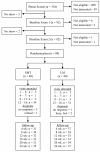Illustrating risk difference and number needed to treat from a randomized controlled trial of spinal manipulation for cervicogenic headache
- PMID: 20497573
- PMCID: PMC2893201
- DOI: 10.1186/1746-1340-18-9
Illustrating risk difference and number needed to treat from a randomized controlled trial of spinal manipulation for cervicogenic headache
Abstract
Background: The number needed to treat (NNT) for one participant to benefit is considered a useful, clinically meaningful way of reporting binary outcomes from randomized trials. Analysis of continuous data from our randomized controlled trial has previously demonstrated a significant and clinically important difference favoring spinal manipulation over a light massage control.
Methods: Eighty participants were randomized to receive spinal manipulation or a light massage control (n = 40/group). Improvements in cervicogenic headache pain (primary outcome), disability, and number in prior four weeks were dichotomized into binary outcomes at two thresholds: 30% representing minimal clinically important change and 50% representing clinical success. Groups were compared at 12 and 24-week follow-up using binomial regression (generalized linear models) to compute the adjusted risk difference (RD) between groups and number needed to treat (NNT) after adjusting for baseline differences between groups. Results were compared to logistic regression results.
Results: For headache pain, clinically important improvement (30% or 50%) was more likely for spinal manipulation: adjusted RD = 17% to 27% and NNT = 3.8 to 5.8 (p = .005 to .028). Some statistically significant results favoring manipulation were found for headache disability and number.
Conclusion: Spinal manipulation demonstrated a benefit in terms of a clinically important improvement of cervicogenic headache pain. The use of adjusted NNT is recommended; however, adjusted RD may be easier to interpret than NNT. The study demonstrated how results may depend on the threshold for dichotomizing variables into binary outcomes.
Trial registration: ClinicalTrials.gov NLM identifier NCT00246350.
Figures


Similar articles
-
Dose-response and efficacy of spinal manipulation for care of cervicogenic headache: a dual-center randomized controlled trial.Spine J. 2018 Oct;18(10):1741-1754. doi: 10.1016/j.spinee.2018.02.019. Epub 2018 Feb 23. Spine J. 2018. PMID: 29481979 Free PMC article. Clinical Trial.
-
Comparative Effects of Mulligan's Mobilization, Spinal Manipulation, and Conventional Massage Therapy in Cervicogenic Headache-A Prospective, Randomized, Controlled Trial.Healthcare (Basel). 2022 Dec 29;11(1):107. doi: 10.3390/healthcare11010107. Healthcare (Basel). 2022. PMID: 36611567 Free PMC article.
-
An Additive Effect of Instrument-Assisted Soft Tissue Mobilization with Spinal Manipulation in Cervicogenic Headache: a Randomized Controlled Trial.Pain Ther. 2024 Dec;13(6):1679-1693. doi: 10.1007/s40122-024-00671-w. Epub 2024 Oct 28. Pain Ther. 2024. PMID: 39467979 Free PMC article.
-
Methodological quality of randomized controlled trials of spinal manipulation and mobilization in tension-type headache, migraine, and cervicogenic headache.J Orthop Sports Phys Ther. 2006 Mar;36(3):160-9. doi: 10.2519/jospt.2006.36.3.160. J Orthop Sports Phys Ther. 2006. PMID: 16596892 Review.
-
Complementary and alternative therapies for back pain II.Evid Rep Technol Assess (Full Rep). 2010 Oct;(194):1-764. Evid Rep Technol Assess (Full Rep). 2010. PMID: 23126534 Free PMC article. Review.
Cited by
-
Impact of Movement Control Training Using a Laser Device on the Neck Pain and Movement of Patients with Cervicogenic Headache: A Pilot Study.Healthcare (Basel). 2023 May 15;11(10):1439. doi: 10.3390/healthcare11101439. Healthcare (Basel). 2023. PMID: 37239725 Free PMC article.
-
Dose-response of spinal manipulation for cervicogenic headache: study protocol for a randomized controlled trial.Chiropr Man Therap. 2016 Jun 8;24:23. doi: 10.1186/s12998-016-0105-z. eCollection 2016. Chiropr Man Therap. 2016. PMID: 27280016 Free PMC article.
-
Headache and neck.Curr Pain Headache Rep. 2011 Aug;15(4):324-31. doi: 10.1007/s11916-011-0195-1. Curr Pain Headache Rep. 2011. PMID: 21465114 Review.
-
Are non-invasive interventions effective for the management of headaches associated with neck pain? An update of the Bone and Joint Decade Task Force on Neck Pain and Its Associated Disorders by the Ontario Protocol for Traffic Injury Management (OPTIMa) Collaboration.Eur Spine J. 2016 Jul;25(7):1971-99. doi: 10.1007/s00586-016-4376-9. Epub 2016 Feb 6. Eur Spine J. 2016. PMID: 26851953
References
Associated data
Grants and funding
LinkOut - more resources
Full Text Sources
Medical
Miscellaneous

